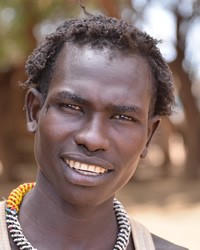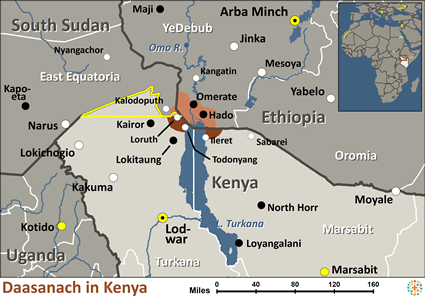The Daasanach are a people with a recent history. Their ties to one another have resulted from a common place of residence rather than from heredity. Exiles from many groups around the area of north Lake Turkana have united in support of one another in this hostile, arid environment. They have developed a unique tradition and culture and are open to the inclusion of other immigrants who are willing to abide by Daasanach customs and values.
Until the turn of the century, very little was known of the Daasanach, sometimes called the Merille. At that time, formal borders were created for many African countries, and the Daasanach found their traditional lands divided between Sudan, Ethiopia and Kenya. Since then, these semi-nomadic people have moved as freely as possible across the borders of these countries, but this movement is being more and more restricted by border posts and entry formalities.
The Daasanach are known for their fighting prowess and are feared by many neighboring groups, such as the Gabbra and Turkana. Raids to obtain more cattle are celebrated, and Daasanach warriors are proud of the number of enemies they have killed.
The Daasanach are reluctant to adopt outside technology. Irrigation systems to aid in agriculture were introduced to this area by American missionaries in the 1960s, but these systems have been disregarded since foreigners were expelled from Ethiopia after the overthrow of Emperor Haile Selassie in 1974.
Today church work is being carried out in Kenya where only ten percent of the Daasanach people live. Here there are very few Daasanach Christians. What is left of earlier church work in Ethiopia is unknown.
The Daasanach people need someone to teach them how to disciple others so they can obey the teachings of the Bible.
Pray for the Lord to reveal his glory to the Daasanach people.
Pray for them to have spiritual discernment and a hunger for truth.
Pray for workers, both in Kenya and South Sudan.
Scripture Prayers for the Daasanach in Kenya.
| Profile Source: Joshua Project |

























